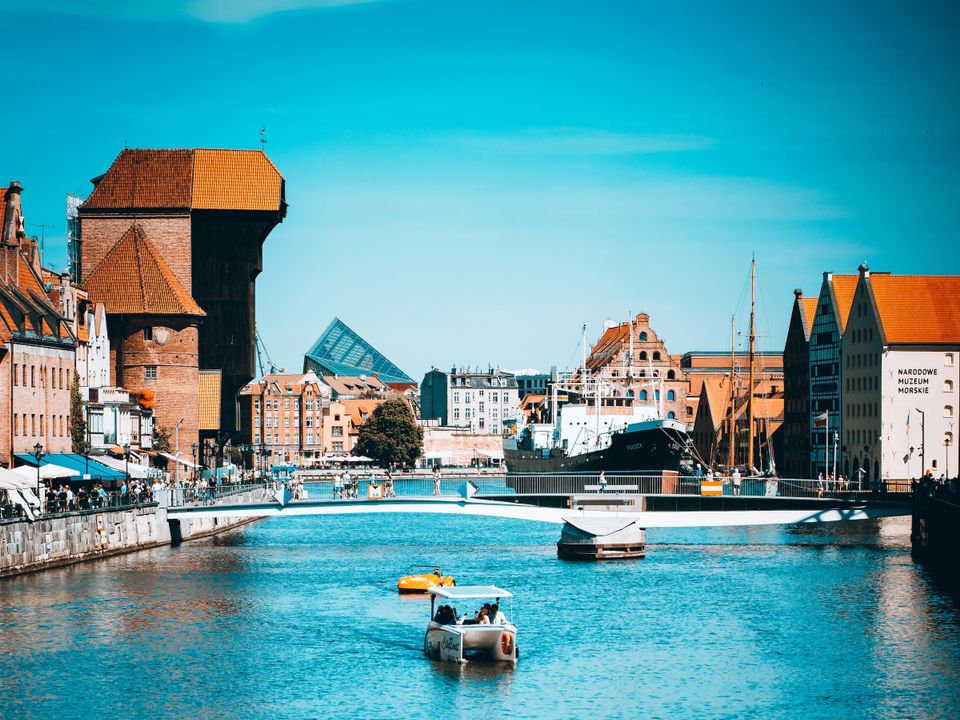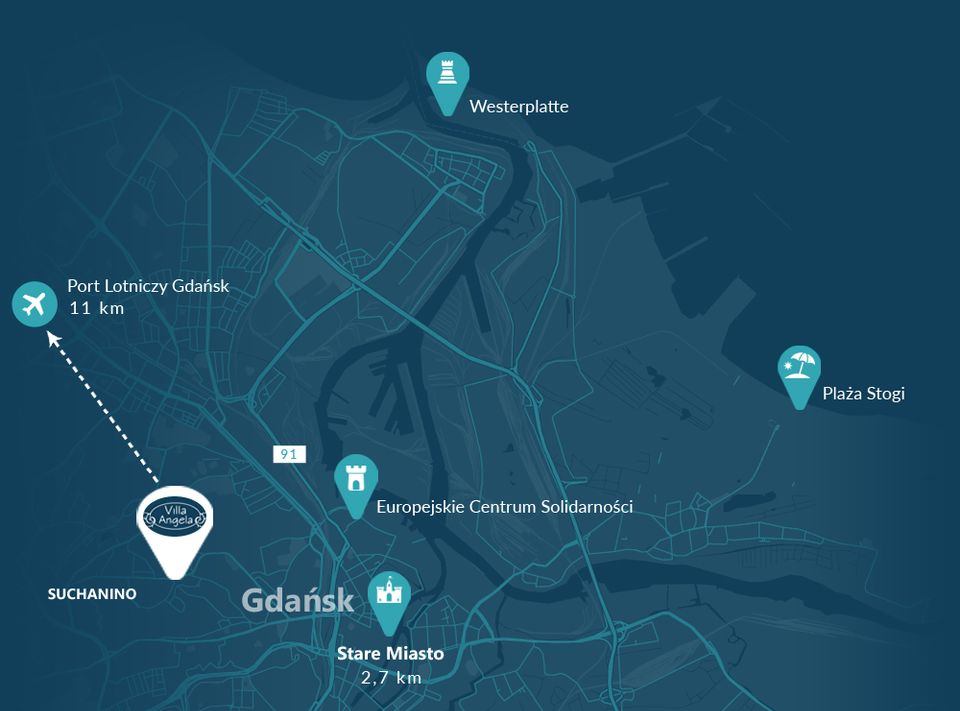Convenient location and a car park
Bicycle rental
By booking via the website, phone or email you will receive 1 hour of cycling free of charge. Please book in advance as bikes can be rented or booked.
European Solidarity Centre
The European Solidarity Centre is a museum dedicated to the people and ideas of the “Solidarity” movement. It is located on the territory of the old shipyard, right next to the historic gate No. 2 and the monument to the fallen shipbuilders. In summer, beautiful fountains are an additional attraction.
Museum of World War II
The Museum of the Second World War is located one step from the old town of Gdańsk (200 meters from the historical building of the Polish Post Office, at Władysław Bartoszewski Square). The main exhibition covers an area of almost 5,000 m2, making it one of the largest exhibitions in the world. In addition, the museum also offers an exhibition for children up to 12 years old, showing the conditions in which Poles lived during and after the war. Visiting this place will definitely not be a boring history lesson.
Upland Gate
Ul. Waly Jagiellońskie, 80-853 Gdansk
The Upland Gate in the old days was the central entrance to the city. It served as a representative function being at the same time a defensive fortification. The Upland Gate is a place of welcoming newcomers, important guests of Gdańsk. Kings entering through the gate were solemnly given the keys to the city. The monument was erected between 1574 and 1576 and was designed by Jan Kramer.
Westerplatte
Ul. Maj. Henryka Sucharskiego, 80-601 Gdansk
Westerplatte is undoubtedly a significant point on the historical map of the coast. On the Gdańsk peninsula, you can see the military transit depot, operating in the years 1926-1939, a shelter, as well as an observation tower. You can reach the place by excursion from the old town of Gdańsk.
Oliwski Park
Ul. Abbot Jacek Rybinskiego, 80-328 Gdansk Oliwa
A historic park in the Oliwa district, on the Oliwa Stream; it is the last of the once numerous urban gardens that have survived to our time and serves as an oasis of beauty and silence in the middle of the city. In addition to numerous vegetation, it also has an interesting history.
crane
Ul. Szeroka 67/68, 80-835 Gdansk
In historical sources we can find mentions of the Crane as early as 1367. Once described as a wooden harbour crane, its present-day appearance refers to the mid-15th century. The original crane turned into gunpowder in the fire of 1442, in its place two years later a crane was built to fulfill defensive tasks.
Gdańsk surroundings
One of the biggest historical attractions is located in Malbork, 50 km away from Gdańsk. In 1274 the construction of the castle began, which became the seat of the Teutonic Order. With him, a settlement called Malbork developed rapidly. The construction of the small castle took about 30 years. After its completion, it was named St. Mary's Castle (German: Marienburg).
In 1309, the town of Malbork and the castle became the seat of the Teutonic State, thanks to the transfer of the Grand Master of the Teutonic Order Siegfried von Feuchtwagen from Venice to Malbork. Due to the move and growing needs, the castle began to be expanded. Within about 40 years, the castle was surrounded by moats and defensive walls and was converted into the High Castle. Since then it was the seat of great masters and dignitaries of the Teutonic Knights.
Malbork Castle is considered to be the largest Gothic stronghold in Europe. In 1997, it was declared a UNESCO World Cultural Heritage Site.
Several kilometers from Gdańsk there is a region of lakes, forests and picturesque moraine hills — Kashuba. If you are going to autumn mushroom picking, you can not miss this area covering the area from the Baltic Sea to the Tuchola Bory.
Kashubia is both a wealth of nature, but also local culture and traditions. Tourist attractions include: the open-air museum and the observation tower in Wdzydzy Kiszewski, the Museum of Kashubian Pottery in Chmielno, the highest mountain in Kashubia in Wieżyca, as well as Szymbark with the famous house standing on the roof and the longest plank in the world. Kashuby is also a paradise for sailors and kayaking enthusiasts.
The mainstay of Kashubian fishing tradition and at the same time a popular summer holiday destination is the Hel Peninsula with Jastarnia, Jurata, Kuźnica, Chałupa and Hel.
Right next to Gdańsk is the resort of Sopot, famous for its longest wooden pier in Europe, an amphitheater in the forest cover — the world-famous Forest Opera, which hosts numerous concerts and festivals and Monte Cassino street commonly known as Monciak with its unique Crooked House.
From Sopot you can go directly to the bordering Gdynia with the most beautiful Orłowo cliff on the coast and the summer theater exhibiting plays on the beach. It is worth visiting the Kosciuszko Square and visiting the ship — the museum “Dar Pomorza” and the Oceanarium.
There are still many attractions to visit, such as the picturesque Żuławy, the Vistula Spit, the castle in Gniew and many, many others.
Archcathedral St. Mary's Basilica
Podkramarska 5 Street, 80-834 Gdansk
St. Mary's Basilica in Gdańsk could be called the crown of the city. The monumental structure erects vaults high to the sky, the towers reach above the city skyline. Most likely, in the place of today's St. Mary's Basilica, once stood the church of the Blessed Virgin Mary built in the 13th century during the princely times of Świętopełka II.
Fountain of Neptune
Długi Targ 43 Street, 80-828 Gdansk
The Fountain of Neptune, standing in front of the Artus Court since 1633, is a symbol of Gdańsk. The initiator of its creation was the Mayor of Gdańsk Bartłomiej Schachmann. The character of Neptune refers to the connection between Gdańsk and the sea. It was modeled by Peter Husen and Johann Rogge and was cast in 1615 in Augsburg. The author of the design of the entire fountain was Abraham van den Blocke.
Other Attractions
ZOO
The Gdańsk Zoological Garden located in Gdańsk Oliwa is the largest zoological garden in Poland. Here you can find animals from all continents, and even those that you will no longer meet in the wild. Admiring animals is enriched by additional attractions, such as a retro queue.
Energa Stadium
Football stadium in Gdańsk in the Letnica district. Its main user is the football club Lechia Gdańsk. It is also home to the Fun Arena, which forms the largest amusement park in the Tri-City.
Green Gate — Długi Targ 24 Street, 80-828 Gdańsk
The Green Gate is the most magnificent of the gates of the main city. Erected in 1564-1568 as the residence of Polish kings, it replaced the modest, Gothic Kogi Gate. Despite its destiny, the Green Gate never hosted Polish monarchs. She stopped here only by passing, in 1646, Maria Ludwika Gonzaga, the future wife of Władysław IV and later John Casimir.
Golden Gate — Długa Street, Gdansk
It was built between 1612 and 1614 by Jan Starkowski according to the design of Abraham van den Block. Architecturally, it is clear that the building has the elements of the Netherlandish and Italian style of the late Renaissance.
Great Armorownia — Targ Węglowy 4 Street, 80-831 Gdańsk
The greatest example of Dutch Mannerism architecture in Gdańsk and one of the most valuable representatives of this style in Europe is the Great Armory. The building was erected at the beginning of the 17th century according to the design of the outstanding Gdańsk architect Antoni van Obberghen. It used to be the most beautiful arsenal in the world.
Old Town
Part of Gdańsk's Śródmieście district. It is the oldest area of the city, where you can see, among others, the historic fountain of Neptune and St. Mary's Basilica. There is also a crane located there: a water gate, as well as the largest and oldest of the preserved port cranes of medieval Europe.














